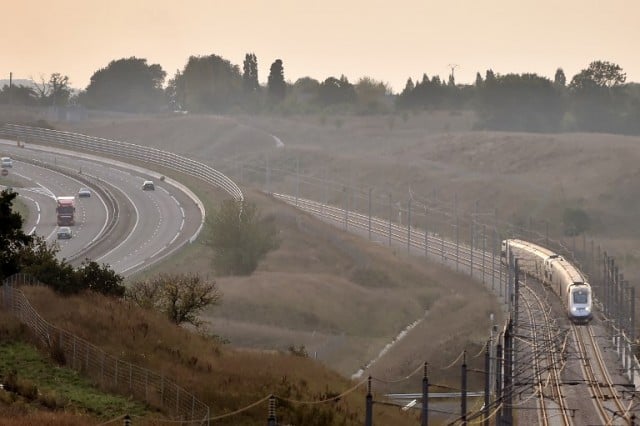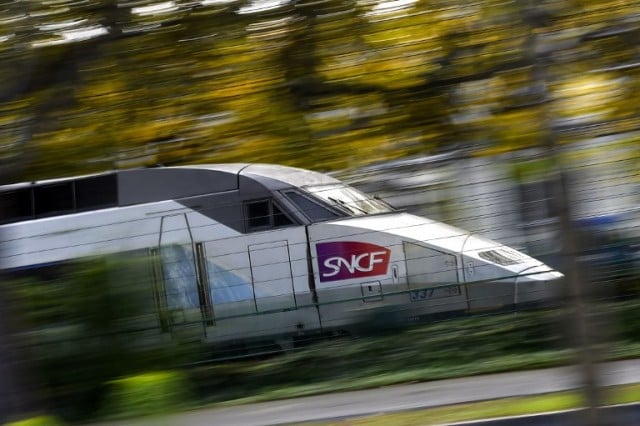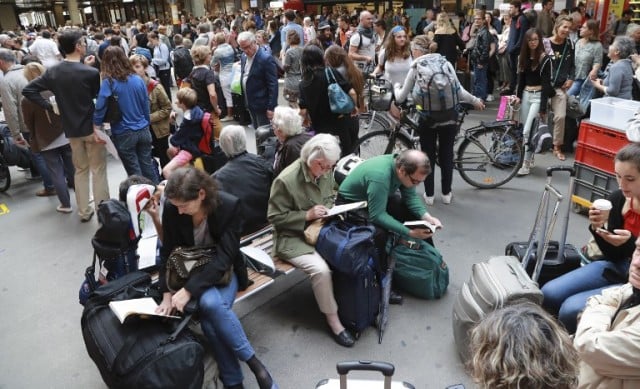The numbers that show France's proud rail service is struggling

France prides itself on its rail service (or at last its TGV trains), but a new report suggests it is not in rude health. Here are the key numbers that tell the story of the state of French rail.
A new report by French rail regulator Arafer revealed a few truths about the state of the rail service in France.
10th
That's France's ranking in Europe for the use of the rail system.
In France an average of 48 trains run daily per kilometre of track which is a fairly poor level of usage compared to other countries. For example the Netherlands runs 140 trains per kilometre of track each day and in Switzerland it is 119. Even the UK (96) and Germany (75) make more use of its rail network than France does.
50 percent
That's the proportion of passenger trains that run on just 9 percent of the country's tracks, meaning half of all services run on just under 10 percent of the total tracks, which illustrates a strong disparity for the use of the network.
Another stat which highlights this problem is that 31 percent of train lines carry just 1 percent of services. In other words a third of the network is not economically viable and could face closure.
READ ALSO:
-
Everything you need to know about taking the train in France
-
France could cut number of stations served by TGV trains
-
'Forget the strikes: I love French trains'
 Down 1 percent
The number of passengers transported on trains in France dropped in 2016 by 1 percent and between 2011 and 2016 the average drop in rail passengers services is 0.5 percent. "This drop in usage reflects a relative loss of attractiveness of the rail model, while other modes of transport show growth over the same period," noted Arafer.
Meanwhile...
14 percent
This figure reflects the rise in coach travel since 2011, which means long distance buses are the one form of transport that is booming in France. In 2015/16, since Emmanuel Macron freed up the economy to allow coach travel, traffic has risen 17 percent.
Both rail and bus transport tails far behind cars in France which are responsible for 88 percent of journeys. Train journeys represent just 9.2 percent of all journeys.
Down 1 percent
The number of passengers transported on trains in France dropped in 2016 by 1 percent and between 2011 and 2016 the average drop in rail passengers services is 0.5 percent. "This drop in usage reflects a relative loss of attractiveness of the rail model, while other modes of transport show growth over the same period," noted Arafer.
Meanwhile...
14 percent
This figure reflects the rise in coach travel since 2011, which means long distance buses are the one form of transport that is booming in France. In 2015/16, since Emmanuel Macron freed up the economy to allow coach travel, traffic has risen 17 percent.
Both rail and bus transport tails far behind cars in France which are responsible for 88 percent of journeys. Train journeys represent just 9.2 percent of all journeys.
 155km/h
That reflects the average speed of France's prestigious high speed TGV trains in France. So although the TGV - the pride of France's rail system can travel over 300 km/h as we are regularly reminded in adverts, the average speed of a journey is well below that. The reasons being the frequency of stops, which of course slows the trains down but also the fact that many TGVs run on normal train lines where the speed limit is 160 km/h.
In reality the TGV doesn't travel that much faster than Intercité trains, for which the average speed is 103 km/h. However this figure may improve given that new high speed lines (LGV) have opened along sections of tracks, notably between Paris an Bordeaux and Paris Strasbourg recently.
20 percent
That's the figure for the number of delayed regional trains in the Provence-Alpes-Côte d'Azur region at rush hour - the worst of all France's regions. The region with the least delays is Brittany (6 percent). The average figure for delayed regional trains around France is 11 percent.
155km/h
That reflects the average speed of France's prestigious high speed TGV trains in France. So although the TGV - the pride of France's rail system can travel over 300 km/h as we are regularly reminded in adverts, the average speed of a journey is well below that. The reasons being the frequency of stops, which of course slows the trains down but also the fact that many TGVs run on normal train lines where the speed limit is 160 km/h.
In reality the TGV doesn't travel that much faster than Intercité trains, for which the average speed is 103 km/h. However this figure may improve given that new high speed lines (LGV) have opened along sections of tracks, notably between Paris an Bordeaux and Paris Strasbourg recently.
20 percent
That's the figure for the number of delayed regional trains in the Provence-Alpes-Côte d'Azur region at rush hour - the worst of all France's regions. The region with the least delays is Brittany (6 percent). The average figure for delayed regional trains around France is 11 percent.
 6.2 million minutes
This represents the time wasted by passengers due to late trains in 2015. And 55 percent of those "lost minutes" were due to reasons that could have been avoided, rather than natural causes for example, defective equipment or infrastructure or mismanagement of works.
40,000
That's the number of regional TER trains that were cancelled in France at the last minute in 2016 (1.9 percent of all services).
18 percent
That's the percentage of TGV services that were delayed; Around 20 percent of all delayed TGV trains are more than 30 minutes late.
6.2 million minutes
This represents the time wasted by passengers due to late trains in 2015. And 55 percent of those "lost minutes" were due to reasons that could have been avoided, rather than natural causes for example, defective equipment or infrastructure or mismanagement of works.
40,000
That's the number of regional TER trains that were cancelled in France at the last minute in 2016 (1.9 percent of all services).
18 percent
That's the percentage of TGV services that were delayed; Around 20 percent of all delayed TGV trains are more than 30 minutes late.
Comments
See Also
A new report by French rail regulator Arafer revealed a few truths about the state of the rail service in France.
10th
That's France's ranking in Europe for the use of the rail system.
In France an average of 48 trains run daily per kilometre of track which is a fairly poor level of usage compared to other countries. For example the Netherlands runs 140 trains per kilometre of track each day and in Switzerland it is 119. Even the UK (96) and Germany (75) make more use of its rail network than France does.
50 percent
That's the proportion of passenger trains that run on just 9 percent of the country's tracks, meaning half of all services run on just under 10 percent of the total tracks, which illustrates a strong disparity for the use of the network.
Another stat which highlights this problem is that 31 percent of train lines carry just 1 percent of services. In other words a third of the network is not economically viable and could face closure.
READ ALSO:
- Everything you need to know about taking the train in France
- France could cut number of stations served by TGV trains
- 'Forget the strikes: I love French trains'

Down 1 percent
The number of passengers transported on trains in France dropped in 2016 by 1 percent and between 2011 and 2016 the average drop in rail passengers services is 0.5 percent. "This drop in usage reflects a relative loss of attractiveness of the rail model, while other modes of transport show growth over the same period," noted Arafer.
Meanwhile...
14 percent
This figure reflects the rise in coach travel since 2011, which means long distance buses are the one form of transport that is booming in France. In 2015/16, since Emmanuel Macron freed up the economy to allow coach travel, traffic has risen 17 percent.
Both rail and bus transport tails far behind cars in France which are responsible for 88 percent of journeys. Train journeys represent just 9.2 percent of all journeys.

155km/h
That reflects the average speed of France's prestigious high speed TGV trains in France. So although the TGV - the pride of France's rail system can travel over 300 km/h as we are regularly reminded in adverts, the average speed of a journey is well below that. The reasons being the frequency of stops, which of course slows the trains down but also the fact that many TGVs run on normal train lines where the speed limit is 160 km/h.
In reality the TGV doesn't travel that much faster than Intercité trains, for which the average speed is 103 km/h. However this figure may improve given that new high speed lines (LGV) have opened along sections of tracks, notably between Paris an Bordeaux and Paris Strasbourg recently.
20 percent
That's the figure for the number of delayed regional trains in the Provence-Alpes-Côte d'Azur region at rush hour - the worst of all France's regions. The region with the least delays is Brittany (6 percent). The average figure for delayed regional trains around France is 11 percent.

6.2 million minutes
This represents the time wasted by passengers due to late trains in 2015. And 55 percent of those "lost minutes" were due to reasons that could have been avoided, rather than natural causes for example, defective equipment or infrastructure or mismanagement of works.
40,000
That's the number of regional TER trains that were cancelled in France at the last minute in 2016 (1.9 percent of all services).
18 percent
That's the percentage of TGV services that were delayed; Around 20 percent of all delayed TGV trains are more than 30 minutes late.
Join the conversation in our comments section below. Share your own views and experience and if you have a question or suggestion for our journalists then email us at [email protected].
Please keep comments civil, constructive and on topic – and make sure to read our terms of use before getting involved.
Please log in here to leave a comment.